Are you looking for plants with vibrant colors but limited in space? A purple-leaf hanging plant might just be the perfect solution! Known for their association with royalty, luxury, and sophistication, these purple-leaved hanging plants can grow to add a touch of elegance to any indoor or outdoor space. Without further ado, let’s take a look at our favorite hanging plant with purple leaves and get ready to enliven your garden!
Table of Contents
Purple and Green Leaf Hanging Plant For Your Consideration
Purple Jacob’s Coat (Acalypha wilkesiana)

Planting Zones: 10 to 11
Soil: High organic matter, well-draining
Watering: Medium
Height: 0.8 to 1.2 feet (24 to 36 centimeters)
This native to Fiji and Pacific Island purple leaf hanging plant is hard to miss. They have distinctive heart-shaped foliage and serrated margins, with tiny flowers that bloom during summer. To keep the purple Jacob’s coat stay in its attractive color, keep them under bright, direct sunlight for a minimum of 6 hours or more daily.
Trailing Coleus (Coleus scutellarioides)
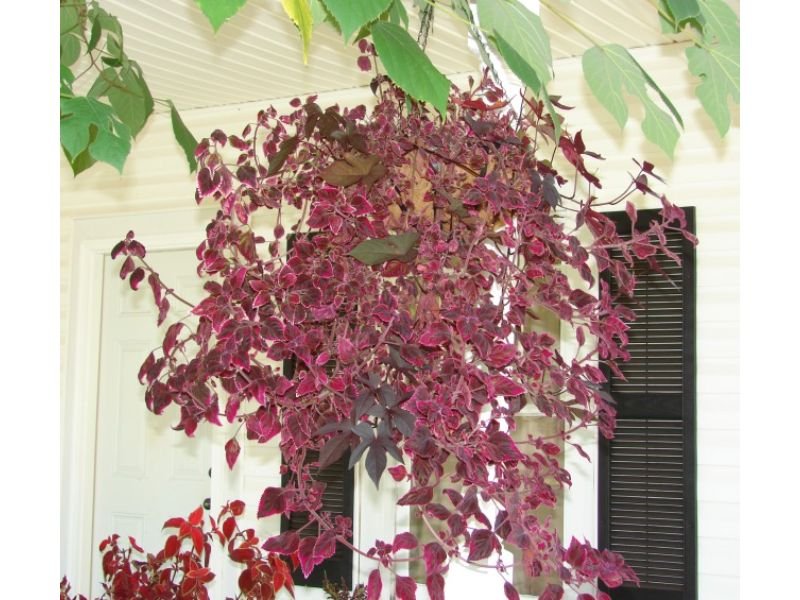
Planting Zones: 10 to 11
Soil: Moist, well-draining
Watering: Medium
Height: 1 foot (30 centimeters) or more
Coleus is a popular houseplant that is noted for its stunning foliage and pattern, which comes in a wide variety of colors and more than 10 cultivars to thrive. They can thrive in both shady and bright areas, but prefer to spend more time in shady areas. Trailing coleus is perfect for plant lovers on any level and will grant you their tremendous foliage color once they are established.
Purple Wandering Jew (Tradescantia zebrina)

Planting Zones: 8 to 12
Soil: Sandy or loamy, well-draining
Watering: Medium
Height: 0.8 to 1.2 feet (24 to 36 centimeters)
Also marketed as an inch plant, this purple-leaf hanging plant stands out for its tiny foliage and foliage pattern that resembles the fur pattern of a zebra. Purple wandering jew produce purple leaves with a combination of silverish-green stripes, which can turn into complete deep dark purple as the plant matures. They prefer slightly acidic soil and are not a fan of the cold.
Royal Velvet Vine (Gynura aurantiaca)
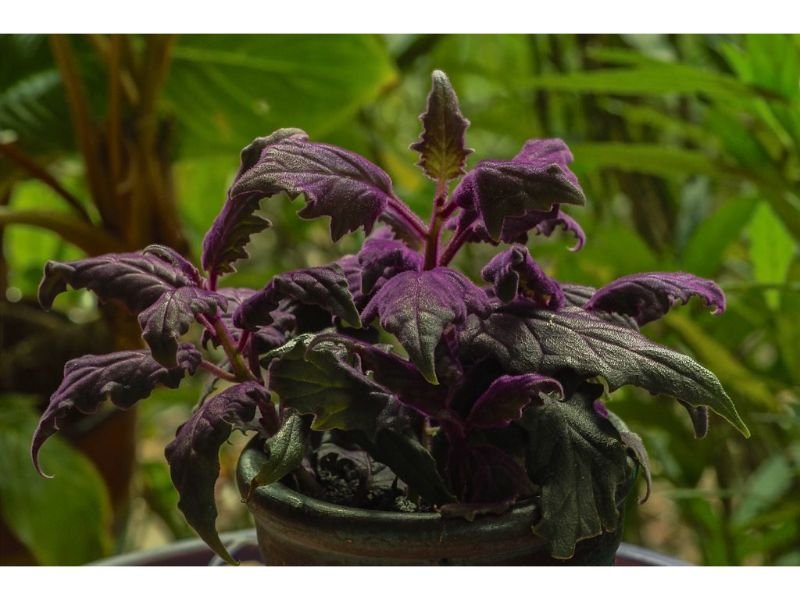
Planting Zones: 10 12
Soil: High organic matter, moist, well-draining
Watering: Medium
Height: 1 to 1.2 feet (30 to 36 centimeters) or more
With royal velvet vine, you can stay calm when the cold season comes, as this native to Indonesia perennial plant remains evergreen. Not only are they remarkably colorful, but this purple-leaf hanging plant also has that velvety texture and glossy look! They love thriving in areas with high humidity but tolerate areas with lower humidity as well. To get the best foliage color, plant the royal velvet vine under bright but indirect light.
Purple Ornamental Sweet Potato Vine (Ipomoea batatas)
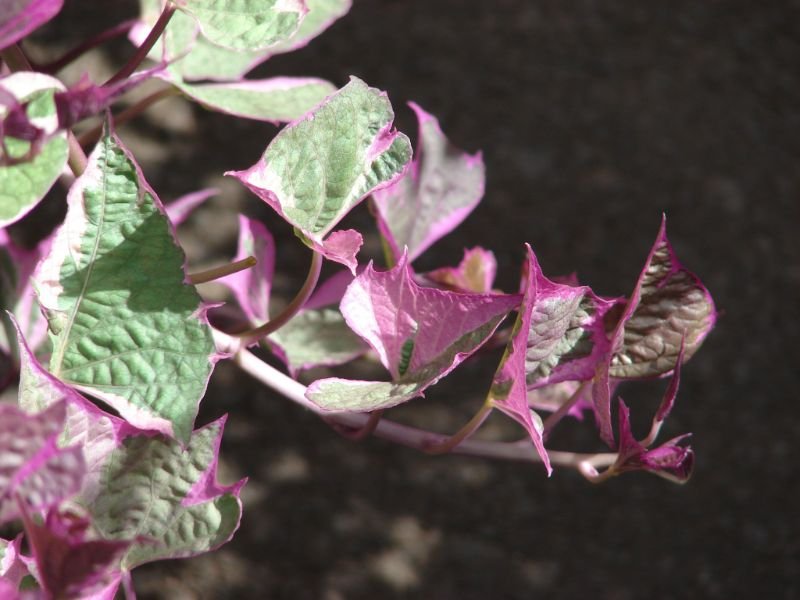
Planting Zones: 9 to 11
Soil: High organic matter, sandy or loamy, well-draining
Watering: Medium
Height: 0.6 to 1.3 feet (18 to 40 centimeters)
If you’d like to incorporate a kid and pet-friendly ornamental plant that is also safely edible, look no other than the purple ornamental sweet potato vine. Plus value to add besides their ease of maintenance, this purple leaf hanging plant also tolerates drought and dry soil, and is a major attraction for pollinators. Not only about aesthetic value, but this plant is also valuable for health purposes, as it contains anti-diabetic and antioxidant properties.
Purple Peperomia (Peperomia caperata)

Planting Zones: 10 to 12
Soil: Loamy or sandy, moist, well-draining
Watering: Medium
Height: 0.6 to 1.25 feet (18 to 38 centimeters)
For those who live in warm and temperate climates, purple peperomia can provide a beautiful addition to an indoor or outdoor landscape. This plant has ovate-shaped foliage with deep dark green purple and silverish veins along with eye-catching burgundy stems. As a native to tropical areas, purple peperomia is a fan of high humidity and is tolerant of areas with heavy shades.
Persian Shield (Strobilanthes var. dyeriana)
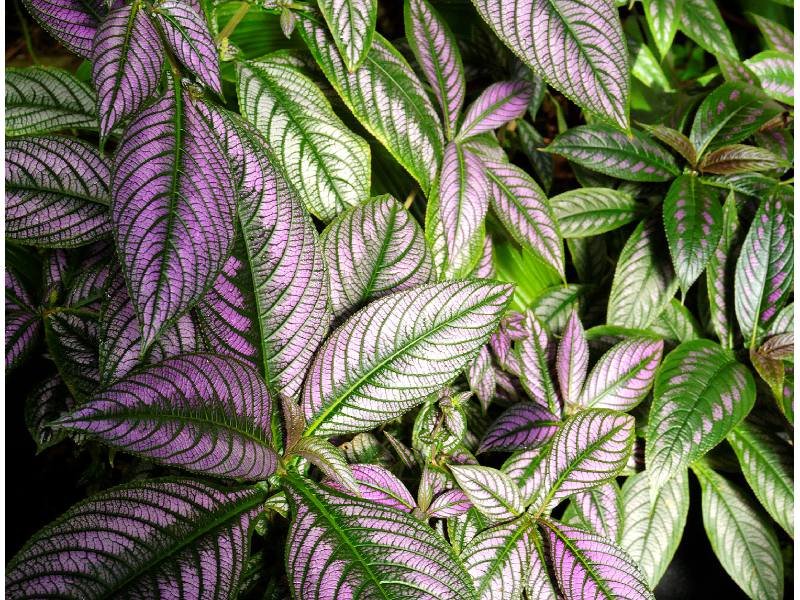
Planting Zones: 8 to 11
Soil: High organic matter, well-draining
Watering: Medium
Height: 5 feet (152 centimeters) or more
With their glossy and smooth foliage texture, it’s easy to see why this purple-leaf hanging plant becomes a common sought-after houseplant. Persian shields thrive best in full sun but tolerate partial light as well. They tolerate heat and humidity but are not fond of frost. A healthy Persian shield shall bloom during spring and winter.
Purple Heart (Tradescantia pallida ‘Purple Heart’)

Planting Zones: 9 to 11
Soil: Loamy, well-draining
Watering: Medium
Height: 0.6 to 0.8 foot (18 to 24 centimeters)
Purple heart is a native to Mexico tender perennial that is noted for its pointed, ovate-shaped dark purple foliage that glows with a hint of silver hue. They grow best under full, direct sun and are somewhat drought-tolerant. Unlike aroids, this plant contains no toxic compounds, so it’s safe for children and pets.
Flowering Kale (Brassica oleracea var. acephala)
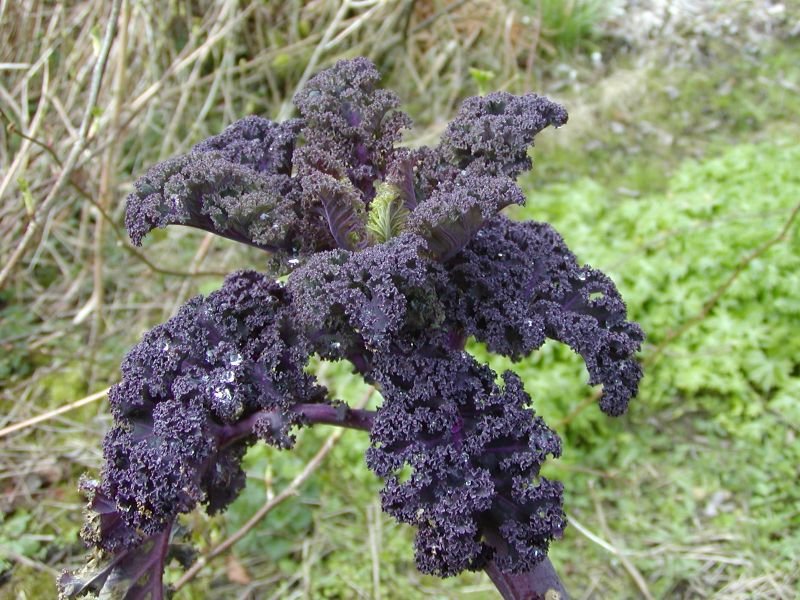
Planting Zones: 2 to 11
Soil: Moist, well-draining
Watering: Medium
Height: 0.5 to 3 feet (15 to 90 centimeters)
Looking for a purple-leaf hanging plant that you can grow as a food plant? The ultimate answer is the cabbage flower-looking flowering kale or ornamental kale! They grow from seeds and are not fond of shady areas. Flowering kale can be grown indoors in larger pots. They survive cold temperatures as low as 5°F (-15°C), but anything below that can harm them. Flowering kale will provide you with its fantastic ruffled rosettes, making them great for those who are also looking for plants to add texture to their landscape.
Purple Coral Bells (Heuchera)

Planting Zones: 3 to 9
Soil: Moist, well-draining, high organic matter
Watering: Medium
Height: 0.6 to 1 foot (18 to 30 centimeters)
Tolerates to a broad variety of soil, purple coral bells are a relatively easy-to-grow variety of Heuchera. They do well under full sun, but also take advantage of thriving in shady areas. Soggy soil is one of the main enemies of this plant, as it can increase the possibility of fungal and pest infection. They do well in 45°F (7°C) temperatures or above.
Are Purple-leaved Hanging Plants Easy To Maintain?
Depending on its cultivar, size, and growing conditions, purple leaf hanging plants can neither be easy nor kind of complicated to thrive. However, in general, they can be quite sensitive to overwatering, so it’s important to let the soil slightly dry out between waterings. Take note to research more specific needs of each plant and provide optimal growing conditions to ensure its health.
Are Purple Leaf Hanging Plants Expensive?
The cost of a purple-leaf hanging plant can vary depending on factors like species, size, marketplace, and availability. Nonetheless, the majority of purple-leaved plants that we mentioned above are fairly cheap and rather easy to get. For those who live in the United States, you can expect a price ranging from $20 to about $300. The more scarce a plant is, the higher its price tends to be.
Final Thoughts: Should You Grow a Hanging Purple Leaf Plant?
With incredible colors and texture, along with being fairly easy to maintain even in smaller spaces, it’s clear to understand why a purple-leaf hanging plant is a popular choice among plant enthusiasts. Even more, if you’re also a fan of purple, there will always be a hanging plant with purple foliage that suits your taste and preferences!

New author in the hood. Loves gardening and flowers are my spirit animals (yes I know they are not animals but I insist). I will be covering most of the flowers’ topics here and occasionally random though as well.






